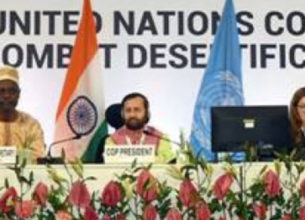HOW INDIA LOST ITS SPOTS?
16, Dec 2019

Prelims level : Environment - Bio Diversity & its Threat
Mains level : GS-III Conservation, Environmental Pollution and Degradation
Why in News?
- In the recent UNCCD COP 14 (United Nations Convention to Combat Desertification), held in Delhi, a researcher from India pronounced desertification as the primary cause of the extinction of the cheetah in India.
- This has reinvigorated debate around Cheetah extinction and slow progress of Cheetah Reintroduction project that was initiated in 2009.
About Cheetah:
- It is the fastest land animal in the world.
- They can be distinguished from other big cats by their smaller size, small head and ears and distinctive “tear stripes” from eye to nose.
- They are diurnal animals and hunt mostly during the late morning or Early Evening.
Habitat:
- Open tall grasslands, scrubs, bushlands, arid and semi-arid open lands.
- Found mostly in open savannah.
Distribution:
- Historically cheetahs were found throughout Africa and Asia including India particularly sal forests in east-central India.
- Today they are now confined to eastern, central and southwestern Africa and a small portion of Iran.
- About 9,000 cheetahs remain in the wild in Africa. In Iran, around 50 cheetahs live in small isolated populations.
Reasons Behind Extinction of Cheetah:
- Loss of grassland habitat: Inability to breed while in captivity meant that wild cheetahs were only found in natural habitats. Thus loss of habitat meant detrimental to Cheetah population which was highlighted at UNCCD COP-14.
- Cheetahs were classified as vermin (harmful to crops and spreads diseases) during British period. This led to rewarding the act of killing of Cheetah.
- Cheetahs were impossible to breed in captivity.
- Hunting because Cheetahs were known to be easy to hunt
Cheetah Reintroduction Programme:
- The last Cheetah died in Chhattisgarh in 1947 after which it was declared extinct in India in 1952.
- Since 1970s India is trying to bring back the big cat from Iran. However due to lower number of cheetahs in Iran it was not considered to be feasible.
- In 2009, the reintroduction project has got a fillip and India was exploring a plan of importing the South African cheetah from Namibia for reintroduction in India.
- 3 regions were shortlisted for reintroduction including:
- The Nauradehi Wildlife Sanctuary and Kuno-Palpur Wildlife Sanctuaries in Madhya Pradesh and the Shahgarh bulge landscape in Jaisalmer, Rajasthan.
- However the project did not take off finally.
Roadblocks encountered in re-introduction of Cheetahs:
- IUCN guidelines require a no-objection certificate for translocation of wildlife species. Besides the guidelines warn against the introduction of alien or exotic species. Finally in December 2018, IUCN gave no-objection certificate for translocation.
- The reintroduction plan to Kuno-Palpur Wildlife Sanctuary hit a roadblock as it was also been shortlisted for introduction of Asiatic Lions from Gir forest in Gujarat. A petition is filed in the Supreme Court with respect to this and the matter is still subjudice.
- Lack of funds hindered the reintroduction project in Nauradehi sanctuary in MP. Recently MP has shown interest in revival of the cheetah reintroduction project here.
About UNCCD:
- United Nations Conference to Combat Desertification
- Established in 1994, UNCCD is the sole legally binding international agreement linking environment and development to sustainable land management.
- The Convention addresses specifically the arid, semi-arid and dry sub-humid areas, known as the drylands, where some of the most vulnerable ecosystems and peoples can be found.
- The Convention’s 197 parties work together to improve the living conditions for people in drylands, to maintain and restore land and soil productivity, and to mitigate the effects of drought. The UNCCD is particularly committed to a bottom-up approach, encouraging the participation of local people in combating desertification and land degradation.
- The UNCCD secretariat facilitates cooperation between developed and developing countries, particularly around knowledge and technology transfer for sustainable land management.
- The permanent Secretariat of the UNCCD was established during the first Conference of the parties (COP 1) held in Rome in 1997. It has been located in Bonn, Germany since January 1999.











